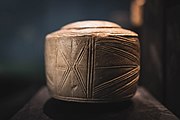| Folkton Drums | |
|---|---|
 Folkton Drums displayed in the British Museum | |
| Material | Chalk |
| Size | 8.7 cm (height) |
| Created | 2600–2100 BC |
| Discovered | 1889 |
| Present location | British Museum |
| Identification | P&EE 1893 12-28 15-17 |
The Folkton Drums are a very rare set of three decorated chalk objects in the shape of drums or solid cylinders dating from the Neolithic period. Found in a child's grave near the village of Folkton in northern England, they are now on loan to Stonehenge Visitor Centre from the British Museum. [1] A similar object, the Burton Agnes drum was found 15 miles away near Burton Agnes in 2015, [2] and another example, the Lavant drum, was excavated in 1993 in Lavant, West Sussex. [3]
Contents
Their purpose remains obscure. They were given the name "drum" to describe their shape, rather than from any thought they might be percussion instruments.






